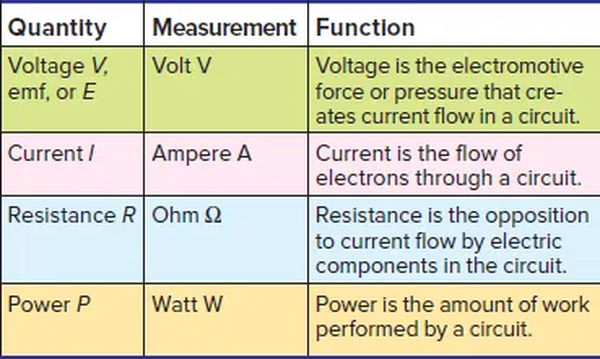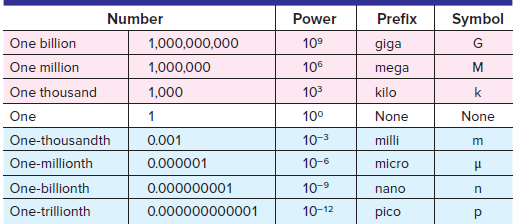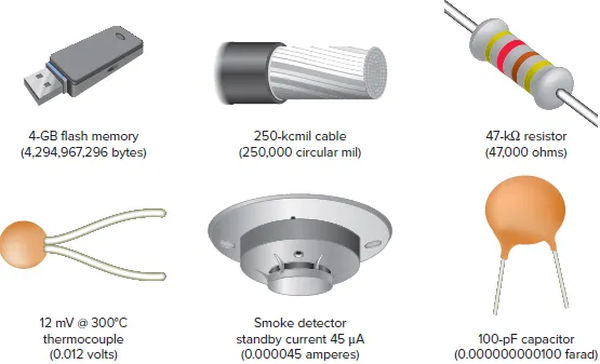Metric Prefixes
Current, voltage, resistance, and power are the most common quantities gauged in electric circuits. The most common values for measuring them are the ampere, volt, ohm, and watt. The names and symbols for these fundamental electrical quantities are provided in Table 1.

The standard electrical units of volt, ampere, ohm, and watt are either too small or too large to be expressed conveniently in some circuit applications. The use of metric prefixes is commonplace in this context. The likelihood of misinterpretation is diminished when one is familiar with the meaning of prefixes. Table 2 lists some commonly used prefixes for metric systems.

A metric prefix precedes a unit of measure or its symbol to form decimal multiples or submultiples.
The use of prefixes in numerical equivalences allows for a reduction in the number of leading zeros. In an electrical system, for instance, a sensor’s signal strength might be 0.00125 V while the voltage applied to the input of a distribution transformer might be in the 27,000 V range. After adding appropriate prefixes, these numbers would read 1.25 mV (millivolts) and 27 kV (kilovolts). A few common prefixes used in the rating of electrical components are illustrated in Figure 1.

When working with digital multimeters or electric circuit formulas, knowing how to convert metric prefixes back to base units is crucial. The number of times the decimal point is moved from one base unit to a multiple or submultiple of that unit is depicted in Figure 2 and the following examples.

EXAMPLE 1
By shifting the decimal point three places to the right, one can convert amperes (A) to milliamperes (mA) (this is the same as multiplying the number by 1,000).

EXAMPLE 2
Changing from mA to A requires shifting the decimal point three places to the left (this is the same as multiplying by 0.001).

EXAMPLE 3
Volts (V) can be converted to kilovolts (kV) by shifting the decimal point to the left by three places.

EXAMPLE 4
The decimal point must be moved six places to the right when converting from megohms (MΩ) to ohms (Ω).

EXAMPLE 5
Shift the decimal point six places to the left to go from microamperes (μA) to amperes (A).

Review Question
- Exactly what is the symbol for electricity’s fundamental unit, and what is it?
- Current.
- Resistance.
- Power.
- Fill in the appropriate metric prefix and symbol for the following:
- One-thousandth.
- One million.
- One millionth.
- One thousand.
- Convert the following:
- 2,500 Ω to kilohms
- 120 kΩ to ohms
- 1,500,000 Ω to megohms
- 2.03 MΩ to ohms
- 0.000466 A to micro-amps
- 0.000466 A to milliamps
- 378 mV to volts
- 475 Ω to kilohms
- 28 μA to amps
- 5 kΩ + 850 Ω to kilohms
- 40,000 kV to megavolts
- 4,600,000 μA to amps
- 2.2 kΩ to ohms
Review Questions – Answers
- (a) Ampere A, (b) Volt V, (c) Ohm Ω, (d) Watt W
- (a) Milli m, (b) Mega M, (c) Micro μ, (d) Kilo k
- (a) 2.5 kΩ, (b) 120,000 Ω, (c) 1.5 MΩ, (d) 2,030,000 Ω, (e) 466 μA, (f) 0.466 mA, (g) 0.378 V, (h) 0.475 kΩ, (i) 0.000028 A, (j) 5.85 kΩ, (k) 40 MV, (l) 4.6 A, (m) 2,200 Ω